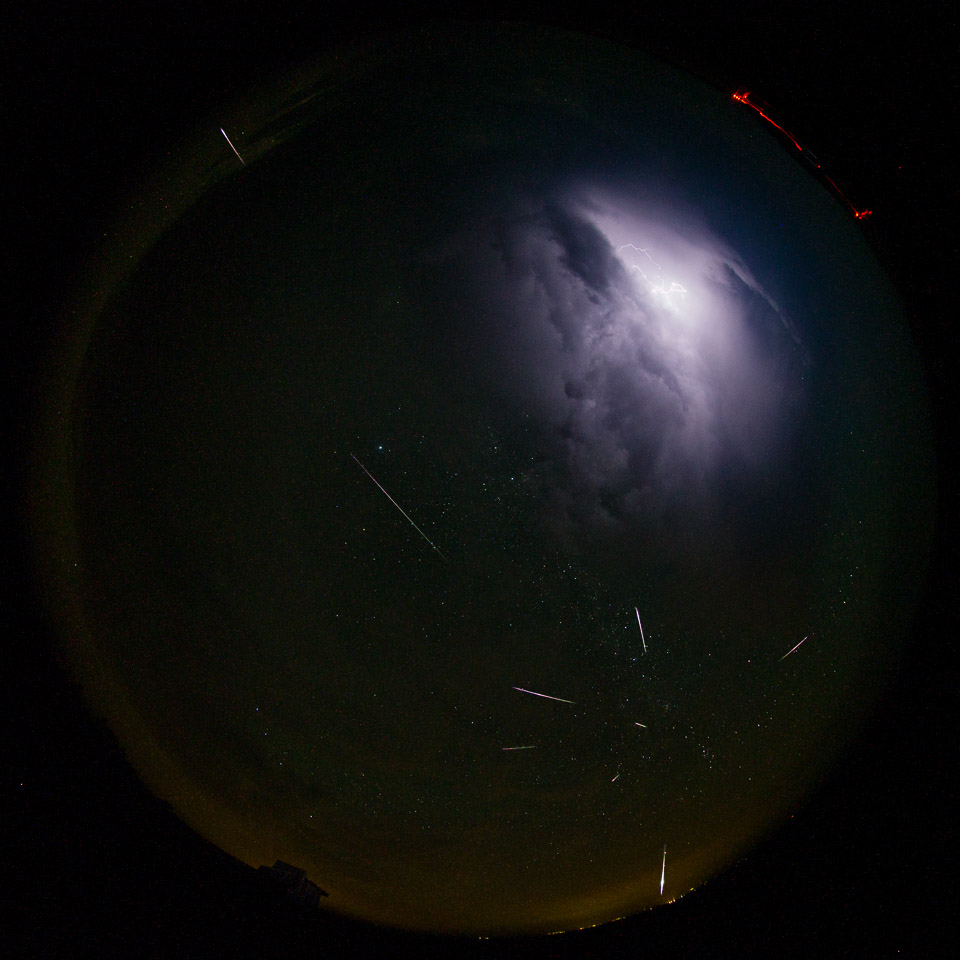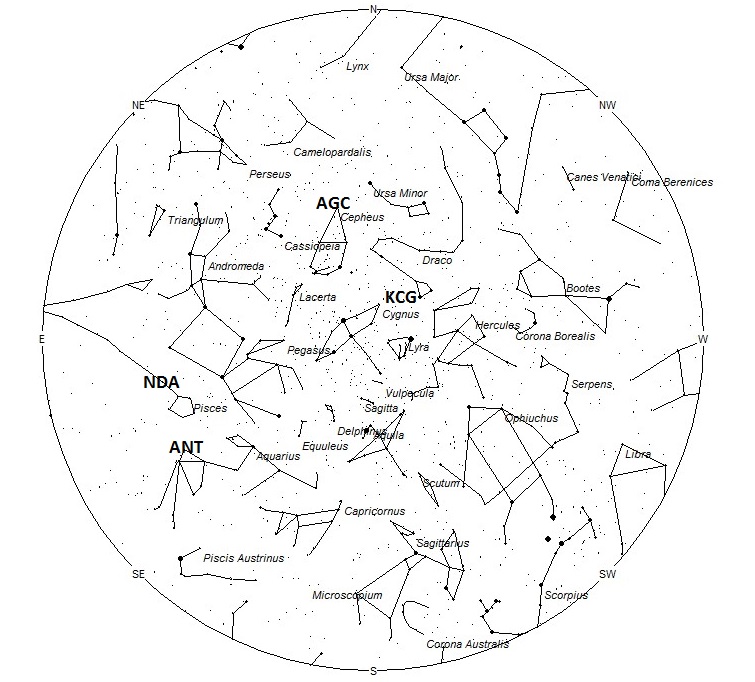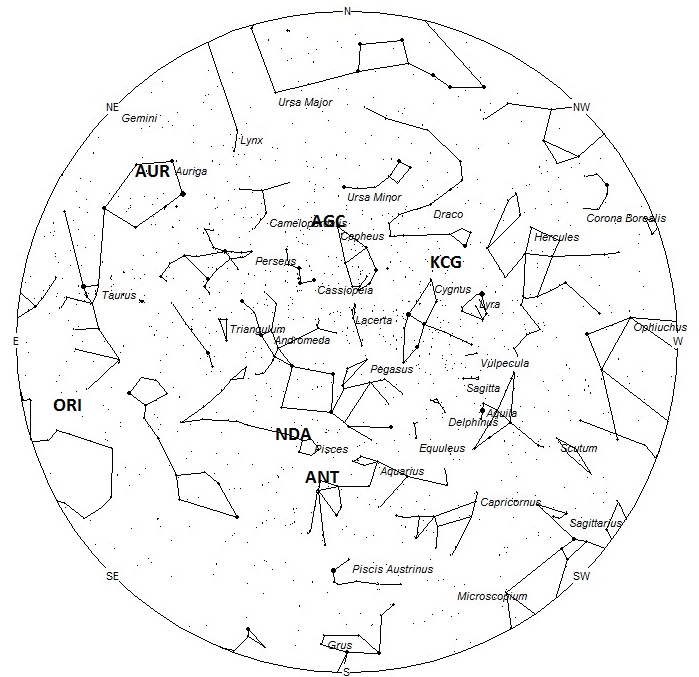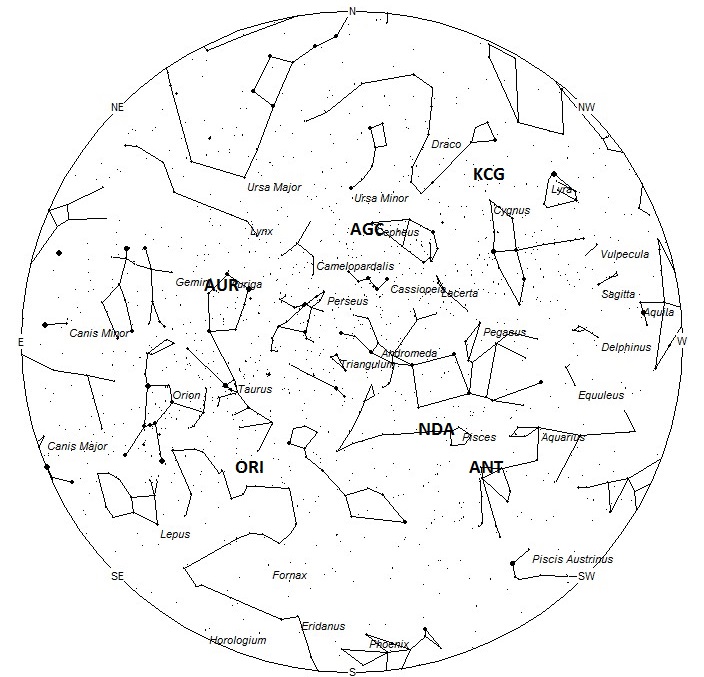
Perseid Meteors and Lightning by Wade Earle, August 11th 2015 (composite photo) – Oregon, USA
During this period the moon reaches its new phase on Thursday September 1st. At this time the moon will be located near the sun and will be invisible at night. This weekend the waning crescent moon will rise a few hours before dawn. This will allow unimpeded meteor observations nearly all night long. Even when the moon is above the horizon it will be too thin and too low in the sky to cause problems. The estimated total hourly meteor rates for evening observers this week is near 4 as seen from mid-northern latitudes (45N) and 3 as seen from tropical southern locations (25S). For morning observers the estimated total hourly rates should be near 18 as seen from mid-northern latitudes (45N) and 13 as seen from tropical southern locations (25S). The actual rates will also depend on factors such as personal light and motion perception, local weather conditions, alertness and experience in watching meteor activity. Note that the hourly rates listed below are estimates as viewed from dark sky sites away from urban light sources. Observers viewing from urban areas will see less activity as only the brightest meteors will be visible from such locations.
The radiant (the area of the sky where meteors appear to shoot from) positions and rates listed below are exact for Saturday night/Sunday morning August 27/28 These positions do not change greatly day to day so the listed coordinates may be used during this entire period. Most star atlases (available at science stores and planetariums) will provide maps with grid lines of the celestial coordinates so that you may find out exactly where these positions are located in the sky. A planisphere or computer planetarium program is also useful in showing the sky at any time of night on any date of the year. Activity from each radiant is best seen when it is positioned highest in the sky, either due north or south along the meridian, depending on your latitude. It must be remembered that meteor activity is rarely seen at the radiant position. Rather they shoot outwards from the radiant so it is best to center your field of view so that the radiant lies at the edge and not the center. Viewing there will allow you to easily trace the path of each meteor back to the radiant (if it is a shower member) or in another direction if it is a sporadic. Meteor activity is not seen from radiants that are located below the horizon. The positions below are listed in a west to east manner in order of right ascension (celestial longitude). The positions listed first are located further west therefore are accessible earlier in the night while those listed further down the list rise later in the night.
These sources of meteoric activity are expected to be active this week.
The Kappa Cygnids (KCG) were expected to peak near August 17th. Activity will continue through the remainder of the month. The radiant is currently located at 18:20 (275) +55. This area of the sky is actually located in southern Draco, 5 degrees northeast of the 2nd magnitude star known as Eltanin (gamma Draconis). These meteors are best seen as soon as it becomes dark in the evening hours. Rates are expected to be less than 1 per hour no matter your location. These meteors are not well seen from the southern hemisphere due to a low radiant altitude. With an entry velocity of 23 km/sec., the average Kappa Cygnid meteor would be of slow velocity.
The center of the large Anthelion (ANT) radiant is currently located at 23:08 (347) -05. This position lies in northern Aquarius near the faint star known as phi Aquarii. These meteors may be seen all night long but the radiant is best placed near 0200 local daylight saving time (LDT) when it lies on the meridian and is positioned highest in the sky. Due to the large radiant area, meteors from this source may also appear to radiate from western Pisces and southern Pegasus as well as Aquarius. Rates at this time should be near 2 per hour no matter your location. With an entry velocity of 30 km/sec., the average Anthelion meteor would be of slow velocity.
The Northern delta Aquariids (NDA) are active from August 8 through September 1, with the peak falling on August 19th. These meteors have a radiant currently located at 23:56 (359) +07. This area of the sky is located in western Pisces, near the position of the faint star known as omega Piscium. The radiant is best placed near 0300 LDT, when it lies highest in the sky. Rates are expected to be near 1 per hour no matter your location. With an entry velocity of 39 km/sec., most activity from this radiant would be of average velocities.
The August gamma Cepheids (AGC) were first noticed by members of the Croatian Meteor Network using their video data and that of SonotaCo. This source is active from August 22nd through September 1st with maximum activity occurring on August 28th. The current radiant position lies at 00:04 (001) +77. This area of the sky lies in northern Cepheus, just east of the 3rd magnitude star known as Errai (gamma Cephei). Current rates would be less than 1 per hour no matter your location. This radiant is poorly placed for viewing south of the equator so very little activity is likely to be seen from the southern hemisphere. With an entry velocity of 41 km/sec., the average meteor from this source would be of medium velocity.
You may be surprised to see the Orionids (ORI) as an active radiant this time of year, but there is clear evidence from the IMO video database that this shower is active long before its October 22nd maximum. In fact it is in the top four most active radiants throughout September. This radiant is currently located at 03:44 (056) -02, which places it in northern Eridanus, near the Taurus border. The closest star of note is 4th magnitude Rana (delta Eridani), which lies 8 degrees to the south. This area of the sky is best placed in the sky during the last hour before dawn, when it lies highest above the horizon in a dark sky. Current rates would be near 1 per hour no matter your location. With an entry velocity of 67 km/sec., most activity from this radiant would be of swift speed.
The Aurigids (AUR) are first seen on August 28th and peak on Wednesday morning August 31st. On the morning of maximum activity, the radiant will be located at 06:02 (091) +39. This position lies in central Auriga, two degrees north of the third magnitude theta Aurigae. At maximum, hourly rates will range from 3-5 in the northern hemisphere down to 0-2 in the southern hemisphere. The radiant is well placed for northern observers high in the northeastern sky during the last hour before the start of morning twilight. South of the equator, this shower is not well seen as it lies low in the northern sky during the morning hours. With an entry velocity of 67 km/sec., most activity from this radiant would be swift.
As seen from the mid-northern hemisphere (45N) one would expect to see approximately 14 sporadic meteors per hour during the last hour before dawn as seen from rural observing sites. Evening rates would be near 3 per hour. As seen from the tropical southern latitudes (25S), morning rates would be near 9 per hour as seen from rural observing sites and 2 per hour during the evening hours. Locations between these two extremes would see activity between the listed figures.
The table below presents a list of radiants that are expected to be active this week. Rates and positions are exact for Saturday night/Sunday morning except where noted in the shower descriptions.
| SHOWER | DATE OF MAXIMUM ACTIVITY | CELESTIAL POSITION | ENTRY VELOCITY | CULMINATION | HOURLY RATE | CLASS |
| RA (RA in Deg.) DEC | Km/Sec | Local Daylight Saving Time | North-South | |||
| kappa Cygnids (KCG) | Aug 18 | 18:20 (275) +55 | 23 | 23:00 | <1 – <1 | II |
| Anthelions (ANT) | – | 23:08 (347) -05 | 29 | 02:00 | 2 – 2 | II |
| Northern delta Aquariids (NDA) | Aug 19 | 23:56 (359) +07 | 39 | 03:00 | 1 – 1 | IV |
| August Gamma Cepheids (AGC) | Aug 28 | 00:04 (001) +77 | 41 | 03:00 | <1 – <1 | IV |
| Orionids (ORI) | Oct 22 | 03:44 (056) -02 | 67 | 07:00 | 1 – 1 | I |
| Aurigids (AUR) | Aug 31 | 06:02 (091) +39 | 67 | 09:00 | <1 – <1 | II |
 American Meteor Society
American Meteor Society



On September 1st, my husband and I saw the biggest meteor ever. It was almost 6am. And we were heading North and it was about this address. 4697 Potters Road, Matthews, (stallings), nc
Was it a true meteor? We saw it longer than most. And I actually thought it was a helicopter because it was visible for a while. Then, we noticed it was a shooting star instead.
Just let me know what you think. Thanks so much.
Richard,
Your object looks like it was a meteor that was also witnessed by other folks scattered across the Carolina’s and Tennessee. Check out:
http://www.amsmeteors.org/members/imo_view/event/2016/3197
Robert Lunsford
American Meteor Society
Wow! What a nice photo! Do you know if there are any studies about the danger of these meteors in terms of unknown diseases/bacterias they can spread on Earth? I’m curious about that.
Scott and All,
These objects orbit the sun at temperatures near absolute zero in a total vacuum. As they approach the sun they are also bombarded by intense solar radiation. If this doesn’t kill any possible living thing occupying the meteoroid then the intense heat generated by the atmosphere when these objects reach the earth will certainly do so.
Robert Lunsford